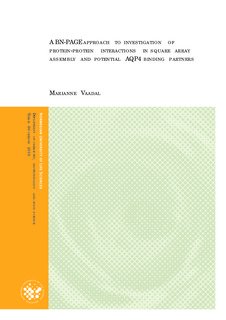| dc.description.abstract | ABSTRACT
Aquaporin 4 (AQP4) is a membrane protein, and also the main water channel in the brain. AQP4 is distributed with highest density in the perivascular end-feet membrane of astrocytes, which are supporting cells of the neurons in the central nervous system.This protein is also involeved in the water and potassium homeostasis, and has been implicated in several neurologic conditions, such as e.g brain edema.
Square arrays are large scale-structures which are present in high consentrations in the same areas as AQP4, and it has been shown that AQP4 is a main contributor in the assembly of square arrays. It has been hypothesized that the ratio of different AQP4 isofoms regulates the size, structure and numerical distribution of square arrays. While square arrays so far has been studied exclusively by freeze-fracture electron microscopy, a group member recently demonstrated a biochemical technique that can be used to analyze square arrays. This technique (BN-PAGE) has been used in this thesis, to test several hypotheses about how to destabilize the square array assembly. This technique has also been used in order to verify for protein-protein interaction between AQP4 isoforms and hypothetical binding partners, e.g the inwardly rectifying potassium channel 4.1 (Kir4.1), α-syntrophin and the tight junction protein, PatJ.
There has recently been an uncertainty about the specificity of immunolabelling using the commercially available anti Kir4.1- antibodies in detection of Kir4.1 proteins.
In the BN-PAGE assay, the use of antibodies is crucial for the detection of present protein. To investigate a hypothetical protein interaction of any protein, a possible cross reaction of antibodies has to be invalidated. In order to test the specificity and crosslabelling of antibodies, a Kir4.1 construct was made for this testing. The construct was later expressed in to different cell lines, HeLa cells and HEK 293 cells, alone or together with AQP4 isoforms, α-syntrophin or PatJ. In addition a mutation study of the isoform AQP4c where tested in the same BN-PAGE assay to investigate the possible protein-protein binding residues between adjacent AQP4-tetramers.
The construct made was verified by sequencing and restriction enzyme (RE) analysis, and the HeLa- expressed construct was also tested with different antibodies against Kir4.1. Since labelling was obtained, we concluded that the construction of Kir4.1 plasmid was successful. In the cross-labelling tests, different antibodies against AQP4 and Kir 4.1 were used. In conclusion, no crosslabelling between AQP4 and Kir4.1 was seen in the assay tested. In the coexpression studies of AQP4 and its potensial binding partner, we were not able to detect any interaction between these proteins using the BN-PAGE assay.
Single, double and triple mutations of AQP4 were tested in the BN-PAGE assay to test if the mutations could destroy square array assembly of AQP4. In additions five N-terminal mutations of AQP4c where also tested. We were not able to reveal any loss of square array assembly in any of these mutations in the BN-PAGE assay.
How the structure of square arrays relates to the isoforms of AQP4, or even what purpose the organization of water channels into these structures serves, is still not understood. SAMMENDRAG
Aquaporin 4 (AQP4) er et membranprotein som danner vannkanaler i hjernen. AQP4-kanaler er normalt konsentrert i perivaskulære membraner endeføttene til astrocytter, som er støtteceller for nevroner i det sentralse nervesystemet. AQP4 har også en viktig rolle i vann og kalium homostasen, og det er vist at vannkanalen AQP4 spiller en utslagsgivende rolle i utviklingen av hjerneødem etter for eksempel hjerne-slag.
”Square arrays” er store kantete strukture som finnes i høye konsentrasjoner i astrocyttenes ende-føtter og som kolokaliseres med AQP4. Det har vist seg at flere AQP4 isoformer er byggesteiner i disse strukturene. Det er gjort spekulasjoner rundt hvorvidt mengden av de ulike AQP4 isoformene bestemmer hvor store strukturene skal bli og hvordan de blir organisert. Elektronmikroskopi av fryse snitt har i mange år vært den eneste tilgjengelige metoden for å analysere ”square-array” strukturene. I 2008 publiserte et gruppemedlem en artikkel hvor et nytt molekylær biologisk verktøy (BN-PAGE) ble verifisert for bruk i forskningen rund oppbygningen av ”square arrays. BN-PAGE metoden har også blitt brukt i denne masteroppgaven, men da for å teste ulike hypoteser som er publisert rundt oppbygningen av disse strukturene. Metoden har også blitt brukt til å undersøke protein-protein interaksjoner mellom AQP4 isoformer, og mellom AQP4 og andre potensielle bindings partnere, for eksempel en kalium kanal (Kir4.1), α-syntrophin og et cytosolisk protein, PatJ.
I det siste har det hersket tvil om hvorvidt enkelte Kir4.1 antistoffer er spesifikke nok for å kunne brukes i kolokalisasjons studier med blant annet AQP4. Antistoff spesifisitet er grunnleggende viktig for å kunne verifisere tilstedeværelse av et bestemt protein i flere analytiske metoder, også i BN-PAGE. Derfor var det viktig at vi kunne verifisere antistoffene som skulle brukes i oppgaven min. Det ble bestemt å lage et Kir4.1 konstrukt, uttrykke dette i ulike cellelinjer, for deretter å teste antistoffene som skulle brukes videre. Etter verifiseringen av antistoffene ble det gjort ekspresjons forsøk hvor Kir4.1 konstruktet ble uttrykt alene eller sammen med en AQP4 isoform, eller en av de andre potensielle bindings proteinene som allerede er nevnt. Det ble ikke gjort resultater som kan bekrefte interaksjoner mellom noen av disse proteinene.
Single, doble og triple mutasjoner ble testet i BN-PAGE systemet i håp om å ødelegge de allerede påviste ”square arrays” av AQP4. Det ble i tillegg gjort en mutasjonstudie hvor isoformen AQP4c ble undersøkt vha den samme metoden for å se om det var mulig å påvise protein interaksjoner mellom bestemte aminosyrer i to AQP4 tetramer komplekser. Heller ikke her ble det vist noen nedbrytning av square array-strukturene.
Det er fortsatt uklart hvordan de ulike isoformene av AQP4 bidrar til oppbyggingen av square array strukturene, og man er heller ikke sikker på hensikten med å organisere AQP4-vann kanalene på en slik måte. | en_US |
